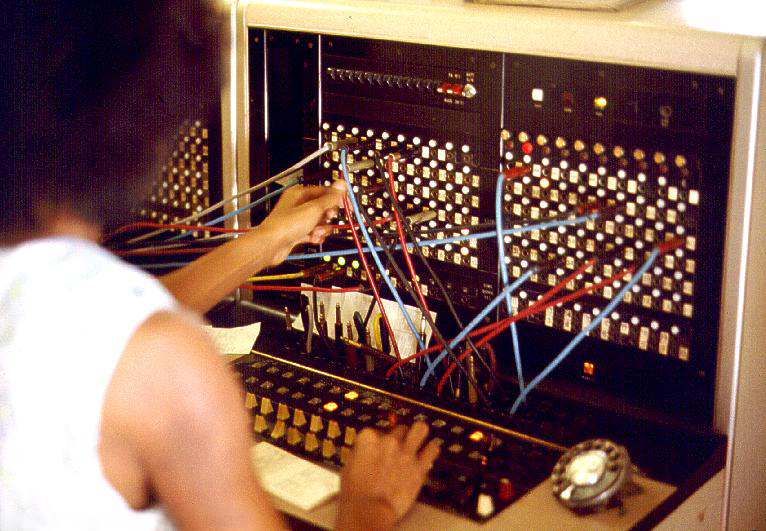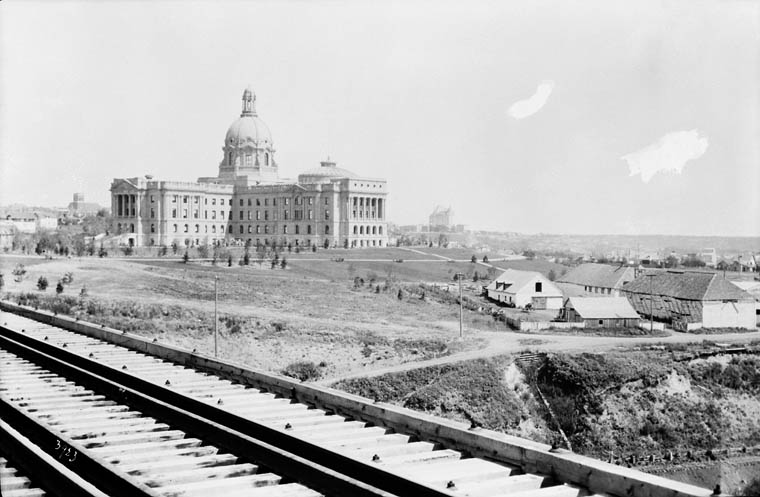|
Telephone Historical Centre
The Telephone Historical Centre was a telecommunications museum located in Edmonton, Alberta dedicated to preserving the history of the telephone in Edmonton. Founded by a group of retired ED TEL employees, the Telephone Historical Centre was opened on December 3, 1987, in a former telephone exchange building in Old Strathcona. In 2004, it moved to its final location in the Prince of Wales Armouries Heritage Centre in Central Edmonton. The Telephone Historical Centre provided both group and individual tours and, as a hands-on museum, allows for visitors to interact with the artifacts. In April 2019, the Edmonton Telephone Historical Centre Foundation voted to dissolve, citing relevancy, financial issues, structural problems and succession planning as the reasons for closing. Collections The Telephone Historical Centre had a large collection of original telephones from as early as 1878, two years after the telephone was invented. The museum also contained replicas of several early tel ... [...More Info...] [...Related Items...] OR: [Wikipedia] [Google] [Baidu] |
Edmonton
Edmonton ( ) is the capital city of the Canadian province of Alberta. Edmonton is situated on the North Saskatchewan River and is the centre of the Edmonton Metropolitan Region, which is surrounded by Alberta's central region. The city anchors the north end of what Statistics Canada defines as the " Calgary–Edmonton Corridor". As of 2021, Edmonton had a city population of 1,010,899 and a metropolitan population of 1,418,118, making it the fifth-largest city and sixth-largest metropolitan area (CMA) in Canada. Edmonton is North America's northernmost large city and metropolitan area comprising over one million people each. A resident of Edmonton is known as an ''Edmontonian''. Edmonton's historic growth has been facilitated through the absorption of five adjacent urban municipalities ( Strathcona, North Edmonton, West Edmonton, Beverly and Jasper Place) hus Edmonton is said to be a combination of two cities, two towns and two villages./ref> in addition to a series ... [...More Info...] [...Related Items...] OR: [Wikipedia] [Google] [Baidu] |
Old Strathcona
Old Strathcona is a historic district in south-central Edmonton, Alberta, Canada. Once the commercial core of the separate city of Strathcona, the area is now home to many of Edmonton's arts and entertainment facilities, as well as a local shopping hub for residents and students at the nearby University of Alberta. The district centres on Whyte Avenue and has shops, restaurants, bars and buskers. Official definitions Provincial historic area In 2007, Old Strathcona was named Alberta's second Provincial Historic Area. The district comprises an area of five city blocks from 85 Avenue south to 80 Avenue and from 102 Street west to 106 street.Canada's Historic PlaceAlberta Register of Historic Places: Old Strathcona Online at: hermis.alberta.ca. Retrieved on: 2012-01-02. Business revitalization zone The Old Strathcona and Area Business Revitalization Zone (BRZ) is a roughly cross-shaped business revitalization zone, extending along Whyte Avenue from just west of 109 S ... [...More Info...] [...Related Items...] OR: [Wikipedia] [Google] [Baidu] |
Alexander Graham Bell
Alexander Graham Bell (, born Alexander Bell; March 3, 1847 – August 2, 1922) was a Scottish-born inventor, scientist and engineer who is credited with patenting the first practical telephone. He also co-founded the American Telephone and Telegraph Company (AT&T) in 1885. Bell's father, grandfather, and brother had all been associated with work on elocution and speech, and both his mother and wife were deaf; profoundly influencing Bell's life's work. His research on hearing and speech further led him to experiment with hearing devices which eventually culminated in Bell being awarded the first U.S. patent for the telephone, on March 7, 1876. Bell considered his invention an intrusion on his real work as a scientist and refused to have a telephone in his study. Many other inventions marked Bell's later life, including groundbreaking work in optical telecommunications, hydrofoils, and aeronautics. Bell also had a strong influence on the National Geographic Society and its ... [...More Info...] [...Related Items...] OR: [Wikipedia] [Google] [Baidu] |
Thomas A
Thomas may refer to: People * List of people with given name Thomas * Thomas (name) * Thomas (surname) * Saint Thomas (other) * Thomas Aquinas (1225–1274) Italian Dominican friar, philosopher, and Doctor of the Church * Thomas the Apostle * Thomas (bishop of the East Angles) (fl. 640s–650s), medieval Bishop of the East Angles * Thomas (Archdeacon of Barnstaple) (fl. 1203), Archdeacon of Barnstaple * Thomas, Count of Perche (1195–1217), Count of Perche * Thomas (bishop of Finland) (1248), first known Bishop of Finland * Thomas, Earl of Mar (1330–1377), 14th-century Earl, Aberdeen, Scotland Geography Places in the United States * Thomas, Illinois * Thomas, Indiana * Thomas, Oklahoma * Thomas, Oregon * Thomas, South Dakota * Thomas, Virginia * Thomas, Washington * Thomas, West Virginia * Thomas County (other) * Thomas Township (other) Elsewhere * Thomas Glacier (Greenland) Arts, entertainment, and media * ''Thomas'' (Burton novel) 1969 nove ... [...More Info...] [...Related Items...] OR: [Wikipedia] [Google] [Baidu] |
Telephone Switchboard
A telephone switchboard was a device used to connect circuits of telephones to establish telephone calls between users or other switchboards, throughout the 20th century. The switchboard was an essential component of a manual telephone exchange, and was operated by switchboard operators who used electrical cords or switches to establish the connections. The electromechanical automatic telephone exchange, invented by Almon Strowger in 1888, gradually replaced manual switchboards in central telephone exchanges around the world. In 1919, the Bell System in Canada also adopted automatic switching as its future technology, after years of reliance on manual systems. Nevertheless, many manual branch exchanges remained operational into the second half of the 20th century in many enterprises. Later electronic devices and computer technology gave the operator access to an abundance of features. A private branch exchange (PBX) in a business usually has an attendant console, or an auto-atten ... [...More Info...] [...Related Items...] OR: [Wikipedia] [Google] [Baidu] |
Stepping Switch
In electrical control engineering, a stepping switch or stepping relay, also known as a uniselector, is an electromechanical device that switches an input signal path to one of several possible output paths, directed by a train of electrical pulses. The major use of stepping switches was in early automatic telephone exchanges to route telephone calls. Later, they were often used in industrial control systems. During World War II, Japanese cypher machines, known in the United States as CORAL, JADE, and PURPLE contained them. Code breakers at Bletchley Park employed uniselectors driven by a continuously rotating motor rather than a series of pulses in the Colossus to cryptanalyse the German Lorenz ciphers. In a uniselector, the stepping switch steps only along or around one axis, although several sets of contacts are often operated simultaneously. In other types, such as the Strowger switch, invented by Almon Brown Strowger in 1888, mechanical switching occurs in two directions, ac ... [...More Info...] [...Related Items...] OR: [Wikipedia] [Google] [Baidu] |
Museums In Edmonton
Edmonton ( ) is the capital city of the Canadian province of Alberta. Edmonton is situated on the North Saskatchewan River and is the centre of the Edmonton Metropolitan Region, which is surrounded by Alberta's central region. The city anchors the north end of what Statistics Canada defines as the "Calgary–Edmonton Corridor". As of 2021, Edmonton had a city population of 1,010,899 and a metropolitan population of 1,418,118, making it the fifth-largest city and sixth-largest metropolitan area (CMA) in Canada. Edmonton is North America's northernmost large city and metropolitan area comprising over one million people each. A resident of Edmonton is known as an ''Edmontonian''. Edmonton's historic growth has been facilitated through the absorption of five adjacent urban municipalities ( Strathcona, North Edmonton, West Edmonton, Beverly and Jasper Place) hus Edmonton is said to be a combination of two cities, two towns and two villages./ref> in addition to a series of ... [...More Info...] [...Related Items...] OR: [Wikipedia] [Google] [Baidu] |
History Of Edmonton
The first inhabitants settled in the area that is now Edmonton, Alberta, Canada around 3,000 BC and perhaps as early as 10,000 BC, when an ice-free corridor opened up as the last ice age ended and timber, water, and wildlife became available in the region. Early history Edmonton, like many places in North America, had been inhabited for thousands of years by First Nations groups. Fur trade In 1795, European traders of the North West Company (NWC) established Fort Augustus north of Edmonton. The Hudson's Bay Company (HBC), a competitor with the North West Company in the North American fur trade, built Edmonton House (later Fort Edmonton) adjacent to Fort Augustus a year later. In 1802, both forts were moved south to the Rossdale Flats, south of present-day downtown Edmonton. The forts were briefly moved north, before they moved back to the Rossdale Flats site in 1813. Following the merger of the HBC and NWC in 1821, the name Fort Augustus was dropped, with operations ... [...More Info...] [...Related Items...] OR: [Wikipedia] [Google] [Baidu] |
History Of The Telephone
This history of the telephone chronicles the development of the electrical telephone, and includes a brief overview of its predecessors. The first telephone patent was granted to Alexander Graham Bell in 1876. Mechanical and acoustic devices Before the invention of electromagnetic telephones, mechanical acoustic devices existed for transmitting speech and music over a greater distance. This distance was greater than that of normal direct speech. The earliest mechanical telephones were based on sound transmission through pipes or other physical media. The acoustic tin can telephone, or "lovers' phone", has been known for centuries. It connects two diaphragms with a taut string or wire, which transmits sound by mechanical vibrations from one to the other along the wire (and not by a modulated electric current). The classic example is the children's toy made by connecting the bottoms of two paper cups, metal cans, or plastic bottles with tautly held string. Some of th ... [...More Info...] [...Related Items...] OR: [Wikipedia] [Google] [Baidu] |
Telecommunications Museums
Telecommunication is the transmission of information by various types of technologies over wire, radio, optical, or other electromagnetic systems. It has its origin in the desire of humans for communication over a distance greater than that feasible with the human voice, but with a similar scale of expediency; thus, slow systems (such as postal mail) are excluded from the field. The transmission media in telecommunication have evolved through numerous stages of technology, from beacons and other visual signals (such as smoke signals, semaphore telegraphs, signal flags, and optical heliographs), to electrical cable and electromagnetic radiation, including light. Such transmission paths are often divided into communication channels, which afford the advantages of multiplexing multiple concurrent communication sessions. ''Telecommunication'' is often used in its plural form. Other examples of pre-modern long-distance communication included audio messages, such as coded drumbea ... [...More Info...] [...Related Items...] OR: [Wikipedia] [Google] [Baidu] |







.jpg)
